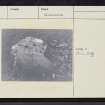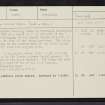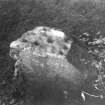Following the launch of trove.scot in February 2025 we are now planning the retiral of some of our webservices. Canmore will be switched off on 24th June 2025. Information about the closure can be found on the HES website: Retiral of HES web services | Historic Environment Scotland
Fortingall Churchyard
Cup Marked Stone (Prehistoric)
Site Name Fortingall Churchyard
Classification Cup Marked Stone (Prehistoric)
Canmore ID 25003
Site Number NN74NW 9
NGR NN 7417 4703
Datum OSGB36 - NGR
Permalink http://canmore.org.uk/site/25003
- Council Perth And Kinross
- Parish Fortingall
- Former Region Tayside
- Former District Perth And Kinross
- Former County Perthshire
NN74NW 9 7417 4703.
The cup marked standing stone in Fortingal churchyard (NN74NW 10) was found in 1903 at a depth of 8' in the part of the burial ground belonging to Sir Donald Currie of Garth, a few feet from the stem of the famous yew-tree. The stone was set up close to the western wall of the Garth burial ground about 25' from its original site.
F R Coles 1910
NN 7417 4703. A cup marked stone, 0.9m x 0.5m and 0.9m high, is set up in the Currie private burial ground. It bears nine cups on its upper surface. The stone has been broken as only a half of two of the cups remains.
Surveyed at 1:10,000.
Visited by OS (NKB) 2 October 1975
No change to previous field report.
Surveyed at 1:2500.
Visited by OS (NKB) 1 December 1978.
Early medieval sculpture
NN 7420 4700 Ivy clearance of the churchyard boundary wall at Fortingall Parish Church has revealed three hitherto unrecognised early medieval sculptures. They are numbered here in sequence with the existing Fortingall sculpture assemblage. All three are of schist.
Fortingall 9. Currently broken into three pieces; c L 176cm; W 29-35cm; Th 3cm. The upper surface of the slab is carved with three recessed equal-armed Latin crosses. The far right cross appears to have a tenon depicted which would suggest that the orientation of the slab is longitudinal, making the cross in question the uppermost one on the slab. Several depictions of tenons on cross-slabs are known.
Fortingall 10. Carved with three recessed equal-armed Latin crosses. L 157cm; W 64cm; Th 9cm. Triple crosses are found on several other Scottish slabs and other media in Insular art.
Fortingall 11. Squarish fragment of a much reduced slab, mortared-in as one of the topstones of the boundary wall; 44 x 51cm. In the middle of the slab, at a slight angle, is an incised cross with shaft, 15 x 6cm. Presumably the stone was originally another recumbent gravemarker.
With 11 extant stones (there is a 12th, missing), Fortingall is now, in a Perthshire context, only surpassed in quantity by the collection of sculptures from Meigle.
M Hall, J Borland and N Robertson 2004














